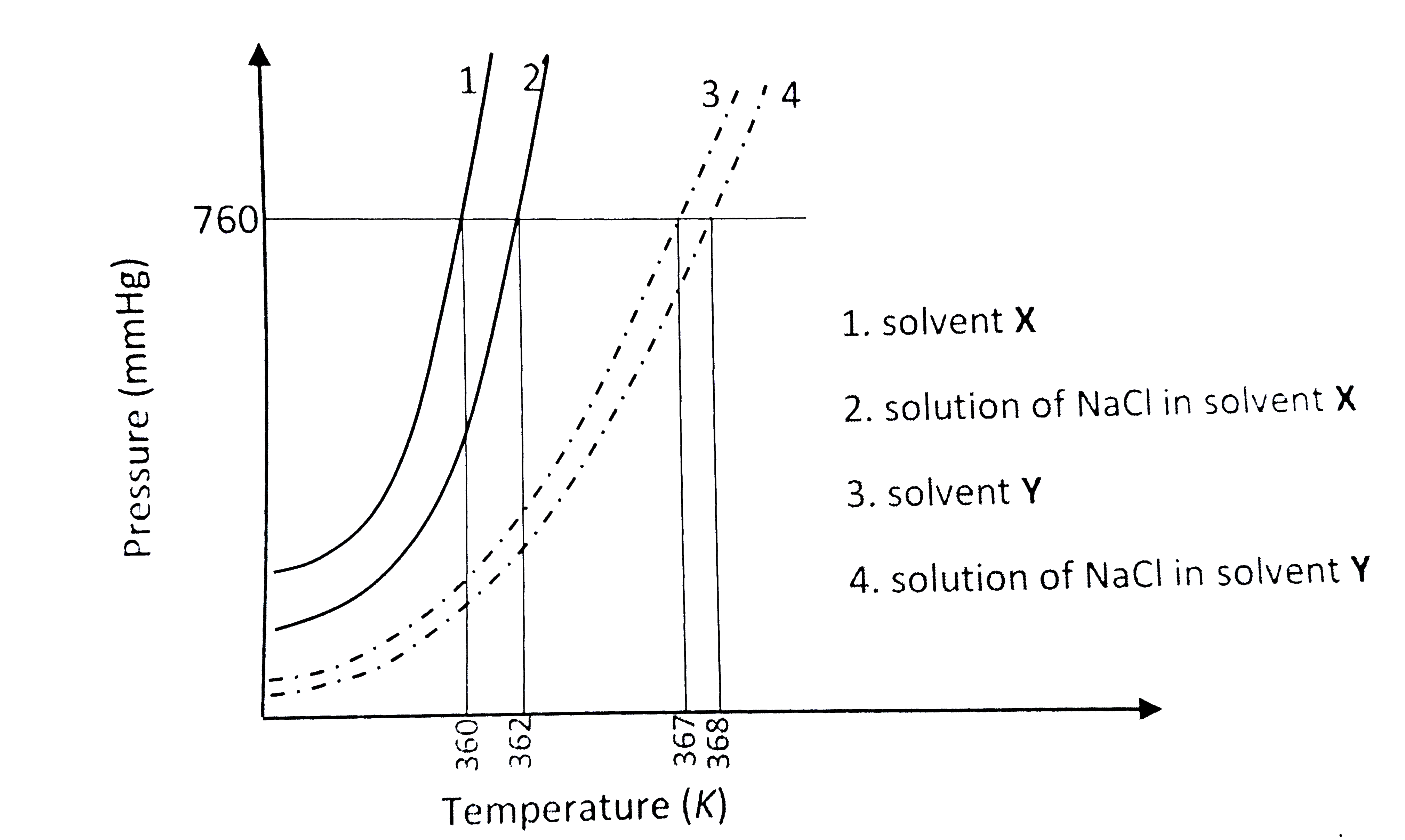The plot given below shows P−T curves (where P is the pressure and T is the temperature) for two solvents X and Y and isomolal solutions of NaCl in these solvents. NaCl completely dissociates in both the solvents.

On addition of equal number of moles of a non-volatile solute S in equal amount (in kg) of these solvents, the elevation of boiling point of solvent X is three times that of solvent Y. Solute S is known to undergo dimerization in these solvents. If the degree of dimerization is 0.7 in solvent Y, the degree of dimerization in solvent X is ____.
Case I. Solution of NaCl
For solvent X : ΔTX=iKBX×nNaCl….(i)
For solvent T : ΔTY=iKBY×mNaCl….(ii)
Dividing (i) and (ii)
ΔTXΔTY=KBXKBY
KbXKbY=21 Since, ΔTX=2,ΔTY=1
Dimerisation of solute S may be given as
2S⇐⇒S2:Total particlest010:1teq1−αα2:1−α2
i=1−α/21
Case II. Solution of solute S
ΔTX=(1−α12)KbX×m
ΔTY=(1−α22)KbY×m
Given : ΔTX=3ΔTY
(1−α12)KbX×m=3(1−α22)KbY×m
2(1−α12)=3(1−α22)
Here KbX=2KbY
Given α=0.7
∴2(1−α12)=3(1−0.72)
α1=0.05.
Topper's Solved these Questions
- BOOK - OP TANDONCHAPTER - SOLUTIONS (GENERAL AND COLLIGATIVE PROPERTIES)EXERCISE - Illustrations47videos
SOLUTIONS (GENERAL AND COLLIGATIVE PROPERTIES)
- BOOK - OP TANDONCHAPTER - SOLUTIONS (GENERAL AND COLLIGATIVE PROPERTIES)EXERCISE - Practice Problem66videos
SOLUTIONS (GENERAL AND COLLIGATIVE PROPERTIES)
- BOOK - OP TANDONCHAPTER - SOLUTIONS (GENERAL AND COLLIGATIVE PROPERTIES)EXERCISE - Self Assessment31videos
SOLUTIONS (GENERAL AND COLLIGATIVE PROPERTIES)
- BOOK - OP TANDONCHAPTER - PROBLEMS BASED UPON STRUCTURES AND REACTIONS OF ORGANIC COMPOUNDS EXERCISE - Some Solved Problems21videos
PROBLEMS BASED UPON STRUCTURES AND REACTIONS OF ORGANIC COMPOUNDS
- BOOK - OP TANDONCHAPTER - STATES OF MATTER (GASES AND LIQUIDS)EXERCISE - Self Assess,ent28videos
STATES OF MATTER (GASES AND LIQUIDS)
Similar Questions
When 50 g of a nonvolatile solute is dissolved in a certain quantity of solvent, the elevation of boiling point is 2.0 K. What will be the elevation of boiling point when 30 g of solute is dissolved in the same amount of the same solvent?
View SolutionAn aqueous solution of 2 per cent (wt./wt) non-volatile solute exerts a pressure of 1.004 bar at the boiling point of the solvent. What is the molecular mass of the solute?
View Solution
Knowledge Check
- Question 1 - Select One
Addition of a non-volatile solute in a volatile ideal solvent
AIncreases the vapoure pressure of the solvent Decreases the vapour pressure of the solventBDecreases the vapoure pressure of the solventCDecreases the boililng point of the solventDIncreases the freezing point of the solvent - Question 2 - Select One
Partial pressure of solvent in solution of non-volatile solute is given by equation.
Ap=x2p∘Bp∘=xpCp=x1p∘Dp∘=x1p - Question 3 - Select One
When non-volatile solute is assed to a pure solvent, the:
Avapour pressure of the solution becomes lower than the vapour pressure of the pure solventBrate of evaporation of solvent is reducedCsolute does not affect the rate of condensationDnone of these
If the mass of a nonvolatil, nonelectrolyte dissolved in a solvent is doubled but that of solvent is quadrupled, the elevation in boiling point of the solvent will be
View SolutionEffect of adding a non-volatie solute to a solvent is"
View SolutionThe elevation in boiling point for one molal solution of a solute in a solvent is called
View SolutionThe elevation in boiling point for one molal solution of a solute in a solvent is called
View SolutionThe elevation in boiling point for one molal solution of a solute in a solvent is called
View Solution

